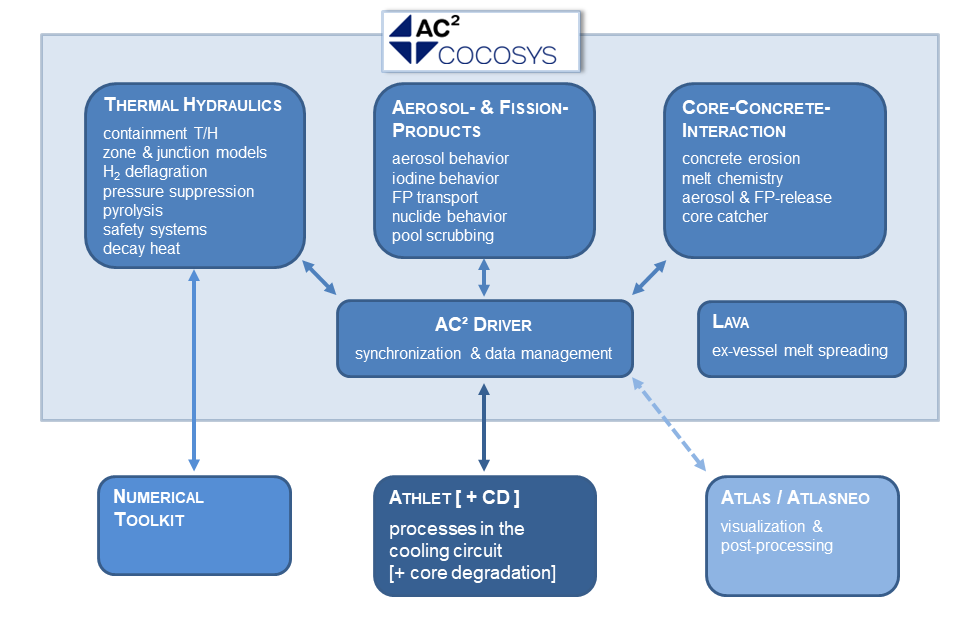The simulation of design basis and severe accident propagation in containments of nuclear power plants is required for the analysis of relevant phenomena during severe accidents with view to both the source term to the environment and possible counter measures. Therefore, at GRS the COntainment COde SYStem (COCOSYS) is being continuously developed and validated. The main objective is to provide a code system on the basis of mechanistic models for the comprehensive simulation of all relevant phenomena, systems and conditions during severe accidents in the containment of light water reactors, also covering design basis accidents.
COCOSYS is briefly described in the COCOSYS Short Description.
In COCOSYS, mechanistic models are used as far as possible for analysing the physical and chemical processes in containments. Essential interactions between the individual processes, like e.g. between thermal hydraulics, hydrogen combustion as well as fission product and aerosol behaviour are considered in a comprehensive way. With such a detailed approach, COCOSYS is not restricted to relevant individual severe accident phenomena, but is also able to account for interactions between these phenomena as well as for the overall behaviour of the containment.
The complete system is divided into several main modules simulating the thermal hydraulics (THY), the aerosol and fission product (AFP/AFP2) behaviour and the core concrete interaction (CCI). The structure of COCOSYS is shown below.

Each main module is a separate computer program, dedicated to one specific area of the overall problem. Communication among these main modules is organised and controlled by the AC2 driver. To keep the complexity of the data exchange within reasonable limits, any data exchange is only allowed between the main modules and the driver.
In AC2, the coupling between ATHLET/ATHLET-CD and COCOSYS is designed to cover the whole plant behaviour. COCOSYS results can be visualised with the ATLAS program.
Validation
In order to keep the modelling at the state-of-the-art, continuative validation is required, supported by software quality assurance as an integral part of the validation and verification process. Thus, COCOSYS is validated on a wide spectrum of separate and integral experiments performed at German or international test facilities. The experiments performed in the former Battelle Model Containment (BMC) and the former Heiß-Dampf-Reaktor (HDR) as well as the ongoing tests in the ThAI facility represent a strong pillar of the COCOSYS validation. Furthermore, GRS participates in several international experimental research programs (OECD THAI / BIP / STEM). The CCI module is validated on the basis of experiments selected from the ACE, OECD-CCI and MOCKA test series.
Applications
Large experience has been gathered at GRS in applying COCOSYS either individually or in a coupled mode with ATHLET/ATHLET-CD. For instance, different projects have been realised in developing plant specific simulators for German BWR or PWR. Within the OECD BSAF and ARC-F projects GRS has used ATHLET-CD/COCOSYS for the Fukushima BWRs (unit 2 and 3). Furthermore, ATHLET-CD and COCOSYS have been used to perform code-to-code comparisons with MELCOR and ASTEC used in PSA level 2 applications for German reactor types. In central and eastern European countries including Russia, COCOSYS is widely applied for Russian WWER and RBMK type NPPs. COCOSYS was applied for specific topics related to AP1000 and EPR plant types.
Release Versions
A history of recent code versions is given below.
- COCOSYS 3.2.0
- COCOSYS 3.1.1
- COCOSYS 3.1.0
- COCOSYS 3.0.1
- COCOSYS 3.0.0
- COCOSYS V2.4v6
- COCOSYS V2.4v5
- COCOSYS V2.4v4
